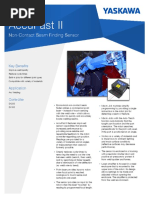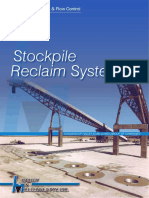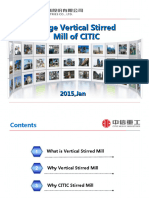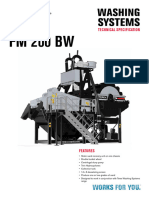Sampling Systems
Sampling Systems
Uploaded by
Widodo PutraCopyright:
Available Formats
Sampling Systems
Sampling Systems
Uploaded by
Widodo PutraOriginal Description:
Copyright
Available Formats
Share this document
Did you find this document useful?
Is this content inappropriate?
Copyright:
Available Formats
Sampling Systems
Sampling Systems
Uploaded by
Widodo PutraCopyright:
Available Formats
DRY SAMPLING SYSTEMS
DRY SAMPLING SYSTEMS
DRY SAMPLING SYSTEMS
The key to any quality or process control program is correct sampling. McLanahan Corporation offers a wide range of sampling equipment to
provide the correct solution to your sampling problem. For more than 50 years, McLanahan Corporation has provided accurate and reliable
sampling solutions to clients across a broad range of industries handling an extensive variety of bulk materials. McLanahan Sampling Systems
are designed to provide a solution to each client’s unique sampling situation while complying with relevant sampling standards, respecting
sampling theory and following industry best practices.
Sampling is the process of selecting a relatively small amount of a material that will correctly represent a larger amount of that same material.
As both producers and consumers of products work to maintain strict quality and process standards, the focus on collecting samples for
analysis that accurately and precisely represent the larger lot of material becomes increasingly important.
CROSS BELT SAMPLERS
Cross Belt Samplers are an easily implemented, cost-effective means of collecting
representative samples and improving the safety of quality and process control
personnel. McLanahan Cross Belt Samplers can be installed on existing conveyor
frames without interfering with the conveyor belt. Top-notch design and expertise at
McLanahan provide a properly engineered and applied solution that will provide the
basis for successful quality and process control programs.
How It Works
A McLanahan Cross Belt Sampler automatically removes a portion of material from
a moving conveyor belt. This is accomplished using a rotating counter-weighted
sample cutter assembly that travels through one 360-degree rotation per activation.
The cutter assembly quickly accelerates from a parked position over the sampler
discharge area and, after a brief period of steady-state motion, passes through the
moving material flow before rapidly stopping in its original parked position above
the sample discharge – ejecting collected sample material into the discharge. Any
fine material that may be present on the surface of the conveyor belt is removed
by a wiper attached to the lower rear surface of the sample cutter. When properly
adjusted, the result is a clean and accurate swipe across the conveyor belt. Cross Belt Sampler
The McLanahan CutZone System
Properly contouring and supporting the conveyor belt is crucial to consistently
collecting complete sample increments with a Cross Belt Sampler, especially
when fine particle sized material is involved. To address this critical requirement,
McLanahan offers the CutZone belt contouring and support system to closely
match the profile of the conveyor belt to the radius of the sample cutter assembly
rotation. The CutZone system consists of two multi-segment idlers that support the
conveyor belt on either side of the sampler and a radiused impact deck that holds
the conveyor belt at the correct profile and prevents deflection of the conveyor belt
while a sample increment is collected. McLanahan CutZone System
Cross Belt Sampler Specifications
Conveyor Belt Width 12”-96” [300mm-2400mm]
Conveyor Belt Speed Up to 1,500ft/min [7.6m/s]
Feed Rate Up to 10,000stph [9000mtph]
Material Size 12” [300mm]
Installed Power Up to 150hp [112kW]
*Standard models. Other options are available depending on application details.
2 | Dry Sampling Systems
DRY SAMPLING SYSTEMS
CROSS BELT SAMPLER-BASED SYSTEMS
Cross Belt Sampler-based multi-stage sampling systems are available in a variety of arrangements and configurations based upon the client’s
sampling application and facility layout requirements. Systems can be provided as an addition to existing infrastructure, as semi-portable skid-
mounted units or in a modular building.
Semi-Portable Skid-Mounted Arrangement Module Building-Based Two Stage Sampling System
Mirrored Module Building-Based Two Stage Sampling Systems Two Stage Sampling System in Existing Structure
Module Building Cutaway
Sample Crusher
Module Top Access Platform
Ventilation Fan
Electrical Room HVAC
Sample Collection Containers
Electrical Room Divider
Bi-Directional Secondary Sample Conveyor
Cross Belt Sampler
Dry Sampling Systems | 3
DRY SAMPLING SYSTEMS
FALLING STREAM SAMPLERS
Falling Stream Samplers are a common type of sampler that are used to collect
sample material from a main process flow that is either in a free-falling condition
or traveling through some trajectory, such as at the discharge of a conveyor.
A Simple Design for Easy Maintenance
Falling Stream Samplers tend to be simpler in design and function and usually
offer highly reliable operation with relatively low maintenance requirements.
This style of sampling is well suited to high flow rate applications where minimal
downtime is a requirement, such as loadout systems. Falling Stream Samplers
come in all manner of shapes, sizes, and configurations, but regardless of the
machine in question, the basic function of this type of machine is essentially the
same. A sample cutter is parked on one side of a moving material flow. When a
sample increment is to be collected, the cutter drive assembly (which varies by
machine type) will move the cutter through the material flow at a constant speed,
collecting a sample increment.
Drive Units
Falling Stream Sampler drive units vary by machine type but are usually one of
three types of drives: gear-reducer driven rack and pinion, gear-reducer driven
chain and sprocket, and hydraulic cylinder.
Bottom Dump Style Sample Cutter
Falling Stream Sampler Specifications
Conveyor Belt Width 12”-96” [300mm-2400mm]
Conveyor Belt Speed Up to 1,500ft/min [7.6m/s]
Feed Rate Up to 20,000stph [18000mtph]
Material Size 12” [300mm]
Installed Power Up to 40hp [30kW]
*Standard models. Other options are available depending on application details.
Falling Stream Style Secondary Sampler Drive Base Assembly for a Standard Duty Overhead Carriage Style
Falling Stream Sampler
4 | Dry Sampling Systems
DRY SAMPLING SYSTEMS
FALLING STREAM SAMPLER-BASED SYSTEMS
Falling Stream Sampling Systems are typically installed in a transfer tower where a conveyor discharges into another portion of a process or
where material is free falling in transfer chutework.
The goal of a sampling program is to accurately represent a relatively large amount of material with a relatively small amount of sample. A
greater amount of sample collection and processing completed within a mechanical sampling system, in an automatic fashion, will result in a
more correct, efficient and cost-effective sampling program.
A complete mechanical sampling system will incorporate as many types of sampling equipment as necessary to meet the needs of the
application and satisfy layout requirements while minimizing the total number of pieces of equipment. More handling and transferring of
samples introduces more potential sources of error into the sample collection and handling process.
Falling Stream Sampler-Based Two Stage Sampling System Falling Stream-Based Loadout Sampling System
Overhead Carriage Style Falling Stream Sampler Two Stage Falling Stream-Based Sampling System
Dry Sampling Systems | 5
DRY SAMPLING SYSTEMS
SAMPLE CRUSHING
Dependable, heavy-duty crushing options for low feed rates is a market niche covered by the McLanahan line of sample crushing products.
From Jaw Crushers, to Hammermills, to Double Roll Crushers, an option likely exists within the McLanahan product offering that will meet your
low tonnage, high dependability requirements.
The McLanahan Sample Hammermill Crushers (MiniMacs) Rockertooth Crushers feature a high crushing ratio and a unique
are typically used in applications processing moderately hard, “rocking” style of impact hammer. They can process mildly abrasive,
friable materials with low abrasiveness. Similar to other types of moderately hard, friable feed material that contains larger lumps
Hammermills, these machines are capable of a high reduction ratio of material or small amounts of harder inclusions. These machines
and can generate a relatively high amount of fines in the crushed can also be fitted with fixed hammers to produce relatively coarse
product. crushed output gradations or for lump breaking applications.
Sample Double Roll Crushers and Mini-Sizers are simply smaller Sample Jaw Crushers are smaller scale versions of the popular
scale versions of the Double Roll Crusher and Direct Drive Crusher overhead eccentric design. Sample Jaw Crushers feature the same
(DDC) product groups for which McLanahan has become well- operating principles and robust design associated with larger jaw
known. These machines tend to produce a more cubical product with crusher offerings in a more compact, lower feed rate configuration.
minimal fines generation.
6 | Dry Sampling Systems
DRY SAMPLING SYSTEMS
AUGER SAMPLERS
In an ideal situation, bulk materials are mechanically sampled from a moving material flow. Examples of ideal sampling locations include on
a moving belt conveyor, free-falling in a vertical chute or as material is discharged from a conveyor at a transfer point. In actuality, this is not
always possible, and other means of sample collection must be used. The most common example of this situation is where material to be
sampled is confined in some type of container for transportation purposes.
Bulk materials are frequently transported via truck, rail, or other container, and often there is no other option for sampling other than to collect
samples from the transport container, particularly in as-shipped and as-received situations. These are the types of applications in which Auger
Sampling Systems are well suited.
Once primary sample increments are collected by the primary Auger Sampler, processing those increments is the same as in any number of
other multi-stage sampling systems for which McLanahan has become well-known.
12” Diameter Sample Auger 20” Diameter Sample Auger
Single Stage Truck Auger System Two Stage Truck Auger System with Sample Building
Dry Sampling Systems | 7
DRY SAMPLING SYSTEMS
OTHER SAMPLING EQUIPMENT
A complete mechanical sampling system can consist of a number of different types of equipment that may not be specifically limited to
sample collection equipment. Other types of equipment can include crushers (Hammermills, Jaw Crushers and Roll Crushers), conveyors,
mixers, dividers and multi-station collectors, to name a few common machines.
Automatic Diverter Gate for Crusher Bypass 2 Station Linear Sample Collector 8 Station Rotary Sample Collector
Vezin Sampler Traveling Hopper Secondary Sampler Motor Control Center
Heavy Duty Sample Conveyor
More Information :
Product Sales : Widodo Putra | 0823 1370 0163 | widodo.putra@beltcare.com
PT. Suprabakti Mandiri
Jl. Danau Sunter Utara Blok A No. 9 Sunter, Jakarta Utara - 14350.
Phone : 021-658 33666 | Fax : 021-658 33666 | e-mail: info@beltcare.com
You might also like
- Interface Installation Audi A6 C7Document5 pagesInterface Installation Audi A6 C7mihaicatalinnNo ratings yet
- PDF Hyundai Engine Maintenance Parts - CompressDocument46 pagesPDF Hyundai Engine Maintenance Parts - Compressapray apray100% (1)
- Dragline or Truck/Shovel? Some Technical and Business ConsiderationsDocument7 pagesDragline or Truck/Shovel? Some Technical and Business ConsiderationsKevin Satrio Adiguna100% (1)
- Accu Fast IIDocument2 pagesAccu Fast IIVimal KumarNo ratings yet
- Swax 7000 Primary Sweep Sampler PDFDocument4 pagesSwax 7000 Primary Sweep Sampler PDFgicnt100% (1)
- Combination of Spoket Yamaha LC 135Document1 pageCombination of Spoket Yamaha LC 135Ahmad FaizalNo ratings yet
- Improving Turnaround Time of Iron Ore Wagons at TransnetDocument153 pagesImproving Turnaround Time of Iron Ore Wagons at TransnetNdee PitsiNo ratings yet
- Sampling Solutions LRDocument8 pagesSampling Solutions LRmanoj983@gmail.com0% (1)
- Mechanical Collection and Within-System Preparation of A Gross Sample of Coal From Moving StreamsDocument9 pagesMechanical Collection and Within-System Preparation of A Gross Sample of Coal From Moving StreamsEugene GudimaNo ratings yet
- Sampling Systems Used For Payment-Risks and BenefitsDocument9 pagesSampling Systems Used For Payment-Risks and BenefitsUmi FitrianingsihNo ratings yet
- Liquid-Solid Separator BrochureDocument4 pagesLiquid-Solid Separator Brochuresrkumar1209gmailcomNo ratings yet
- Joy Sizers BrochureDocument12 pagesJoy Sizers Brochurehilmy yusuf maulanaNo ratings yet
- Moore 2012 PDocument7 pagesMoore 2012 PSACHIDHANANDHAM ANo ratings yet
- Kule 03-04 Arası KonveyorDocument34 pagesKule 03-04 Arası KonveyorHasan arif KısaalioğluNo ratings yet
- XRT Ore Sorting智能分选机宣传册-中英文Document8 pagesXRT Ore Sorting智能分选机宣传册-中英文huanghenghotNo ratings yet
- Alp - Sizer InfoDocument13 pagesAlp - Sizer InfoLê Quang DuyNo ratings yet
- 2016 Ian Hansen Fatality Investigation ReportDocument17 pages2016 Ian Hansen Fatality Investigation Reportbishal pradhan100% (1)
- Dokumen - Tips - Powerscreen Aggwash Agg Powerscreen Aggw A SH Specification Rev 2 07062010Document9 pagesDokumen - Tips - Powerscreen Aggwash Agg Powerscreen Aggw A SH Specification Rev 2 07062010Глеб100% (1)
- Beltscale Handbook 03 12 TLDocument8 pagesBeltscale Handbook 03 12 TLsigitNo ratings yet
- NHI Brief IntroductionDocument56 pagesNHI Brief IntroductionThanhluan NguyenNo ratings yet
- 1286 Sme Mining Engineering Handbook: Figure 12.8-14 Ore-Handling System at Olympic Dam MineDocument1 page1286 Sme Mining Engineering Handbook: Figure 12.8-14 Ore-Handling System at Olympic Dam MineYeimsNo ratings yet
- Kroondal - 1 - Comminution - Circuit - Diagnosis - Study Dec 01 2014 PDFDocument32 pagesKroondal - 1 - Comminution - Circuit - Diagnosis - Study Dec 01 2014 PDFPortia ShilengeNo ratings yet
- YığıcıDocument8 pagesYığıcıumutNo ratings yet
- Material Handling EquipmentDocument9 pagesMaterial Handling EquipmentkaustavNo ratings yet
- SAIL BSBK Visit Docx-15.06. R-1rtfDocument7 pagesSAIL BSBK Visit Docx-15.06. R-1rtfsssadangi100% (1)
- In-Pit Crushing and Conveying (IPCC) - A Tried and Tested Alternative To TrucksDocument8 pagesIn-Pit Crushing and Conveying (IPCC) - A Tried and Tested Alternative To TrucksbamigdimNo ratings yet
- Quarry AcademyDocument2 pagesQuarry AcademydamodarvajjaNo ratings yet
- Verderflex: Industrial Peristaltic Hose PumpsDocument20 pagesVerderflex: Industrial Peristaltic Hose PumpsWilmerNo ratings yet
- Comp - Roll Crusher & SizerDocument2 pagesComp - Roll Crusher & Sizerrajeevup2004100% (1)
- FK Pump and FV Compressor - BrochureDocument8 pagesFK Pump and FV Compressor - BrochureJohn Lester Padilla-DacanayNo ratings yet
- Training Manual Green Anode Plant Vedanta - Jharsuguda: File: 138-02-043 - 11 - 0.doc, Codeword: VedantaDocument17 pagesTraining Manual Green Anode Plant Vedanta - Jharsuguda: File: 138-02-043 - 11 - 0.doc, Codeword: VedantaSubhransu MohapatraNo ratings yet
- Design of Structures For Vibrating Machines RevB (Edgar.Q)Document50 pagesDesign of Structures For Vibrating Machines RevB (Edgar.Q)Nam Nguyen100% (1)
- Allgaier Apt Tro Dryingtechnologiesformineralrawmaterials enDocument12 pagesAllgaier Apt Tro Dryingtechnologiesformineralrawmaterials enesteNo ratings yet
- Large Vertical Stirred Mill of CITICDocument29 pagesLarge Vertical Stirred Mill of CITICJuan Alberto Giglio FernándezNo ratings yet
- Slon Magnetic Separators Applied in TheDocument8 pagesSlon Magnetic Separators Applied in TheMulti DELLNo ratings yet
- CatalogDocument69 pagesCatalogRenzo Chavez100% (1)
- NAWA Spiral ClassifierDocument2 pagesNAWA Spiral ClassifierChandra ShekarNo ratings yet
- Discrete Element Modelling of Vibrating ScreensDocument16 pagesDiscrete Element Modelling of Vibrating ScreensVilayet AlekperovNo ratings yet
- fm200bw SpecsDocument8 pagesfm200bw SpecsГлебNo ratings yet
- ScreeningDocument16 pagesScreeninganthony ijigaNo ratings yet
- Finesmaster 200 CompactDocument9 pagesFinesmaster 200 CompactbogdanmichaelNo ratings yet
- Hazemag HRC en DD LowDocument4 pagesHazemag HRC en DD LowGuilherme Mamede AlcantaraNo ratings yet
- Cavity Level's Effect On Cone Crusher Performance and ProductionDocument11 pagesCavity Level's Effect On Cone Crusher Performance and ProductionMatías TamayoNo ratings yet
- Choosing The Right Motors For Your Mills: Alex Doll and Derek BarrattDocument16 pagesChoosing The Right Motors For Your Mills: Alex Doll and Derek Barrattavca65No ratings yet
- Typical Operating Modes For Stackers and Reclaimers - Aspec - Com.auDocument4 pagesTypical Operating Modes For Stackers and Reclaimers - Aspec - Com.aucajimenezb8872No ratings yet
- Rocklands Group Copper Project FeasibilityDocument73 pagesRocklands Group Copper Project Feasibilitykselvan_1No ratings yet
- Data Sheet For Rotary Calciner - TEPLDocument2 pagesData Sheet For Rotary Calciner - TEPLpuneet gehlotNo ratings yet
- Influence of Matrix Type On WHIMS Performance in The Magn - 2020 - Minerals EngiDocument14 pagesInfluence of Matrix Type On WHIMS Performance in The Magn - 2020 - Minerals EngipHNo ratings yet
- MXC 1200 Cone Crusher BrochureDocument1 pageMXC 1200 Cone Crusher Brochurepmf engineering limitedNo ratings yet
- Crushers: Wills' Mineral Processing Technology. © 2016 Elsevier Ltd. All Rights ReservedDocument24 pagesCrushers: Wills' Mineral Processing Technology. © 2016 Elsevier Ltd. All Rights ReservedDanny Joaquin Flores CruzNo ratings yet
- Scope of Work For Apron Feeder PDFDocument1 pageScope of Work For Apron Feeder PDFSanjay Sharma100% (1)
- Centrifuge PDFDocument11 pagesCentrifuge PDFسراء حيدر كاظمNo ratings yet
- Screen and Cyclones in Concentrators PDFDocument11 pagesScreen and Cyclones in Concentrators PDFAnonymous C0lBgO24iNo ratings yet
- Martin Viper PrecleanerDocument4 pagesMartin Viper PrecleanerVladimir Illich Pinzon BallenNo ratings yet
- TS Primary Sizer - 23L11-DOC-M-PS-001Document56 pagesTS Primary Sizer - 23L11-DOC-M-PS-001sunilkumar100% (1)
- Belt Conveyor Report AnalysisDocument19 pagesBelt Conveyor Report AnalysisNiraj TulaskarNo ratings yet
- Thickeners: Equipment, Systems & Process Innovation - Since 1835Document4 pagesThickeners: Equipment, Systems & Process Innovation - Since 1835ushakunaNo ratings yet
- Calculating DWI From AxbDocument4 pagesCalculating DWI From Axbmushava nyokaNo ratings yet
- F Class Tech SpecsDocument8 pagesF Class Tech SpecskosmcNo ratings yet
- Expandable MandrelsDocument3 pagesExpandable MandrelsMuhammad Ali Masood CheemaNo ratings yet
- 1050 Benefits Realised From Retrofitting A Gravity Gold Recovery CircuitDocument23 pages1050 Benefits Realised From Retrofitting A Gravity Gold Recovery Circuitdjabia100% (1)
- Cortador de Muestras RamseyDocument4 pagesCortador de Muestras RamseyalexNo ratings yet
- Cross Belt Sampling SystemsDocument17 pagesCross Belt Sampling Systemsmahesa34No ratings yet
- Automatic Samplers: Proven & DependableDocument6 pagesAutomatic Samplers: Proven & DependableHarish KumarNo ratings yet
- Urban Voids Unpacked (Master - Thesis)Document116 pagesUrban Voids Unpacked (Master - Thesis)Abrar KhanNo ratings yet
- Rear Derailleur: Important Notice Names of PartsDocument1 pageRear Derailleur: Important Notice Names of PartsRyan MulyanaNo ratings yet
- MCC Name Feeder Number 2F1Document4 pagesMCC Name Feeder Number 2F1AbhijitNo ratings yet
- Management Theory and PracticeDocument12 pagesManagement Theory and PracticeMohit ChaudharyNo ratings yet
- Fault Codes of D12ADocument40 pagesFault Codes of D12AThan MinZawNo ratings yet
- Speed WorksheetDocument1 pageSpeed WorksheetjezzuwafuNo ratings yet
- Port of Brisbane Shipping Handbook 2023 1Document15 pagesPort of Brisbane Shipping Handbook 2023 1dominic dmelloNo ratings yet
- Easa Ad Us-2020-11-04 1Document7 pagesEasa Ad Us-2020-11-04 1Talha stajNo ratings yet
- RFP Radhanpur BypassDocument129 pagesRFP Radhanpur BypassKamal SoniNo ratings yet
- Captain Ab6: Company InformationDocument27 pagesCaptain Ab6: Company InformationPunthep Punnotok100% (1)
- Analysis and Design of Box Type Major BridgeDocument8 pagesAnalysis and Design of Box Type Major BridgeIJRASETPublicationsNo ratings yet
- PSGC Version 30Document156 pagesPSGC Version 30Natalia DominiciNo ratings yet
- WBS HeathrowDocument1 pageWBS HeathrowShakil Reddy BhimavarapuNo ratings yet
- Diagramas Eléctricos Volkswagen Jetta Gls Sedan (9m2) 2.0l (Aeg) 2001.pagina 42pdfDocument1 pageDiagramas Eléctricos Volkswagen Jetta Gls Sedan (9m2) 2.0l (Aeg) 2001.pagina 42pdfJuan AriasNo ratings yet
- FS17 Boat STUDYDocument9 pagesFS17 Boat STUDYJoao CalinhoNo ratings yet
- Republic of The Philippines University of Rizal System Antipolo City, RizalDocument10 pagesRepublic of The Philippines University of Rizal System Antipolo City, RizalElen Singson DulfoNo ratings yet
- Wheel LoadersDocument32 pagesWheel LoadersBROCHIER100% (1)
- TVS IQube ST 51 KWH 34 KWHDocument82 pagesTVS IQube ST 51 KWH 34 KWHcavericeNo ratings yet
- Equivalencia AmortiguadoresDocument304 pagesEquivalencia AmortiguadoresCompras DistrisuperNo ratings yet
- Saab 340ADocument4 pagesSaab 340AJosé A. Montiel QuirósNo ratings yet
- Neerja Bhanot RolepalyDocument4 pagesNeerja Bhanot Rolepalyshivam sharmaNo ratings yet
- Keywords: Driver Seat, Comfort, Safety, Health, AdjustmentsDocument5 pagesKeywords: Driver Seat, Comfort, Safety, Health, AdjustmentsCarwell AbatayoNo ratings yet
- EPC BW 211 D-40 - 58300 - SNo 8432 UpDocument600 pagesEPC BW 211 D-40 - 58300 - SNo 8432 UpRudiansyah RudiNo ratings yet
- G1000 KingAir200 B200 CockpitReferenceGuideDocument104 pagesG1000 KingAir200 B200 CockpitReferenceGuideAde Sudeng100% (1)
- Optimum Layout For A Turbofan EngineDocument37 pagesOptimum Layout For A Turbofan Enginevinod kapateNo ratings yet
- UntitledDocument212 pagesUntitledAtharva ChoudhariNo ratings yet

























































































